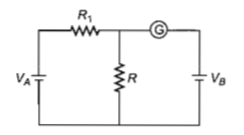A, B, and C are voltmeters of resistance R, 1.5R, and 3R respectively as shown in the figure. When some potential difference is applied between X and Y, the voltmeter readings are VA, VB, and VC respectively. Then,

1. VA=VB=VC
2. VA≠VB=VC
3. VA=VB≠VC
4. VA≠VB≠VC

1. VA=VB=VC
2. VA≠VB=VC
3. VA=VB≠VC
A potentiometer wire of length L and a resistance r are connected in series with a battery of e.m.f. and a resistance r1. An unknown e.m.f. is balanced at a length l of the potentiometer wire. The e.m.f. E will be given by
(1)
(2)
(3)Eol/L
(4)
Two cities are 150 km apart. Electric power is sent from one city to another city through copper wires. The fall of potential per km is 8V and the average resistance per km is 0.5 Ω. The power loss in the wire is
(1) 19.2W
(2) 19.2kW
(3) 19.2J
(4) 12.2kW
A potentiometer circuit has been setup for finding the internal resistance of a given cell. The main battery, used across the potentiometer wire, has an emf of 2.0 V and a negligible internal resistance. The potentiometer wire itself is 4 m long. When the resistance, R, connected across the given cell, has values of
(i)infinity
(ii)9.5Ω
the 'balancing lengths', on the potentiometer wire are found to be 3m and 2.85m, respectively. The value of internal resistance of the cell is
(1) 0.25Ω
(2) 0.95Ω
(3) 0.5Ω
(4) 0.75Ω
In the circuit shown the cells A and B have negligible resistances. For the galvanometer (g) shown no deflection.The value of is
(a)4V (b)2V
(c)12V (d)6V
If voltage across a bulb rated 220 V-100 W drops by 2.5% of its rated value, the percentage of the rated value by which the power would decrease is
(1)20%
(2)2.5%
(3)5%
(4)10%
The power dissipated in the circuit shown in
the figure is 30 Watt. The value of R is :
(1)
(2)
(3)
(4)
If power dissipated in the 9 resistor in the circuit
shown is 36 W, the potential difference across
the 2 resistor is
(a) 8 V
(b) 10 V
(c) 2 V
(d) 4 V
In the circuit in the figure, if the potential at point A is taken to be zero, the potential at point B is :
1. -1V 2. +2V
3. -2V 4. +1V
A wire of resistance is bent to form a complete circle of radius 10 cm. The resistance between its two diametrically opposite points, A and B as shown in the figure, is :
(a) (b)
(c) (d)











